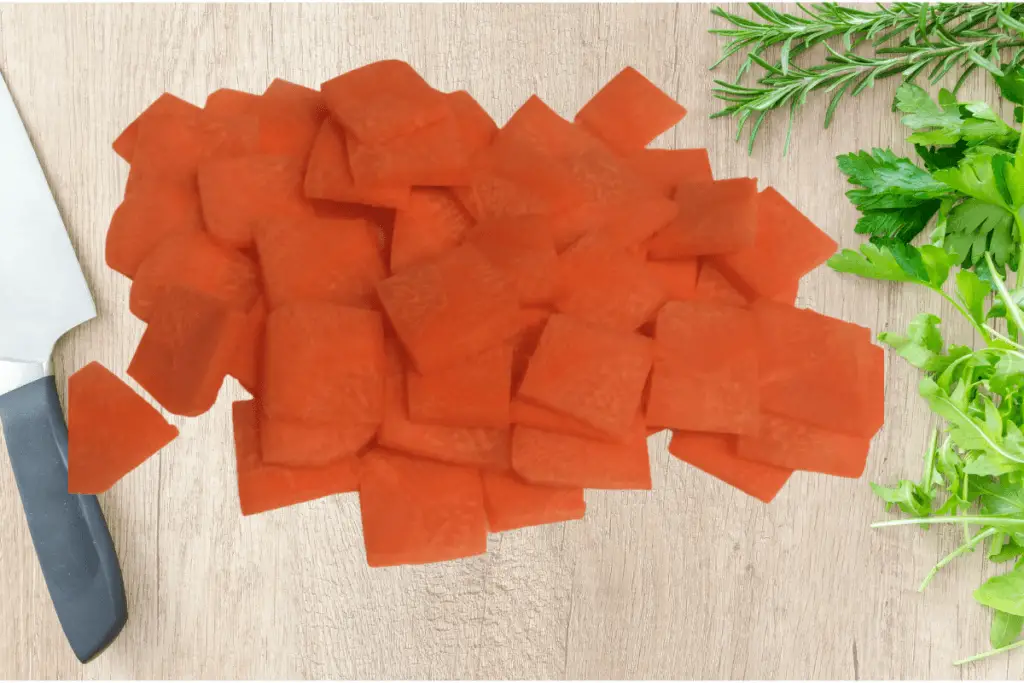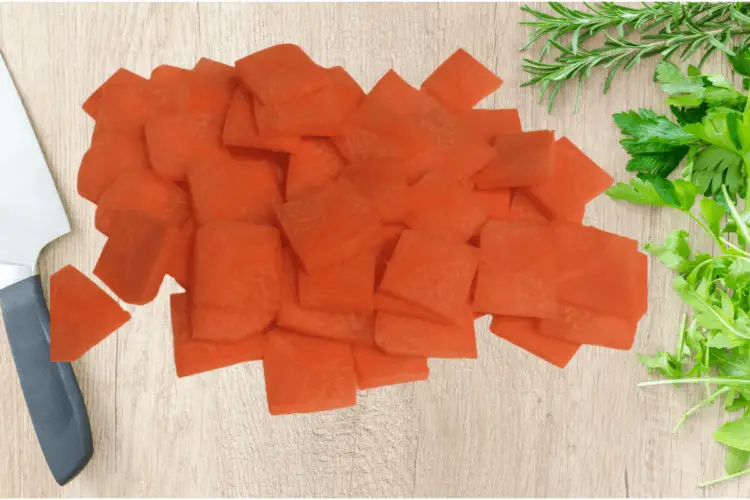Have you ever been in awe of a dish’s exquisite presentation in a fine dining establishment? The careful and expert use of knife cuts is a significant factor in the visual appeal of these creations. The Paysanne cut, a mainstay in traditional French cooking and known for its elegant square shapes, can help you impress your family and guests with dishes that are both aesthetically pleasing and delicious.
Paysanne Cut

Paysanne is a cut of vegetables prepared in slices about 1 mm thick, used for soups when the cooking time is short. An example would be minestrone soup,
Understanding the Paysanne Cut
Vegetables are cut into small, even squares using the Paysanne technique. These delicate squares are a favorite of professional and home cooks alike because they ensure even cooking while also being aesthetically pleasing. By mastering this method, you’ll be able to easily add a dash of sophistication to your meals.
Tools and Ingredients You’ll Need
Before you embark on your Paysanne-cutting journey, gather the following essentials:
- A sharp chef’s knife
- Fresh vegetables (carrots, zucchini, potatoes, and bell peppers work well)
- Cutting board
- Kitchen towel
Step-by-Step Guide to Creating a Paysanne Cut
1. Preparing Vegetables for Cutting
Prepare the vegetables by washing and peeling them.
- Top and tail the veg.
- Now depending on the cut, slice the veg into required lengths.
- On one side trim off a slice so that you have a flat surface to work with.
- Now trim all the sides to produce an even-sided length.
- From here you have the basis to cut any of the different vegetable cuts with ease.
2. Creating the Uniform Squares
- Arrange the vegetable on the cutting board in a horizontal position.
- To make a rectangular plank, cut vertically while maintaining a firm grip.
- Verify the thickness of the plank is about 1/8 inch.
- Next, create thin strips by making vertical cuts along the length of the plank.
- To create uniform squares, stack the strips together and make small, accurate horizontal cuts.
3. Practice Makes Perfect
The Paysanne cut requires practice to master. If your first attempts aren’t perfect, don’t get discouraged. Your knife skills will advance with practice, and your cuts will become more accurate.
Also Read: Parisienne Cut Recipe
Creative Uses of the Paysanne Cut
1. Adding Delightful Texture to Salads
Use Paysanne-cut vegetables in your salads for a delightful crunch and eye-catching presentation. Every forkful has a consistent bite thanks to their uniformity.
2. Even cooking and lovely presentation for stir-fries
Due to their uniform size, Paysanne-cut vegetables cook consistently, making them perfect for stir-fries. Their elegant shape also improves the way your dishes are presented.
3. Adding Garnishes Increases Plate Appeal
Use vegetables that have been Paysanne-cut as garnishes for soups, main dishes, and side dishes. Your culinary creations gain sophistication from their intricate design.
Tips for Getting the Paysanne Cut Right
- Knife Sharpness: Accurate cutting requires a sharp knife. Sharpen your chef’s knife frequently.
- Consistency: To ensure even cooking and a professional presentation, aim for size uniformity.
- Patience: Be patient and practice the technique slowly. Patience is the key to precision.
Knife Safety Precautions and Use
Safety is of the utmost importance when using knives. Always maintain a firm grip on the knife and pay attention to your cutting motion. To avoid accidents, keep your fingers away from the blade.
Conclusion
A culinary method that combines artistry and accuracy is the Paysanne cut. Mastering this cut can take your dishes to new heights because it can turn ordinary vegetables into artistic creations. Accept the process, put in the work, and watch your culinary creations blossom into a feast for the senses.
FAQs
Q: What vegetables lend themselves best to the Paysanne cut?
Firm vegetables like carrots, zucchini, and bell peppers work well with the Paysanne cut.
Q: Can I serve dishes with Paysanne-cut vegetables raw?
Absolutely! Salads and other raw preparations gain texture and appeal from the uniform squares.
Q: Is there a particular kind of knife that is best for the Paysanne cut?
The best option for achieving precise Paysanne cuts is a sharp chef’s knife.
Q: How can I use the Paysanne cut in regular dishes?
Paysanne-cut vegetables can be added to salads, stir-fries, casseroles, and even as decorations.
Q: Needs expert knife skills for the Paysanne cut?
The Paysanne cut is a fantastic technique to learn and master even though it requires a lot of practice because it is accessible to cooks of all skill levels.

